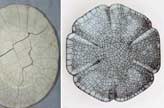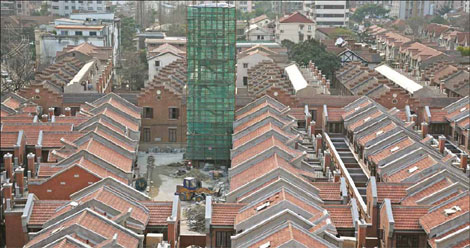Prime
Atlanta Architects have designs on China
Updated: 2011-08-05 11:33
By Trevor Williams (China Daily)
|
Shanghai's Jian Ye Li project is an experiment in historical preservation in a city that spends little time looking back. Provided to China Daily |
ATLANTA - On a warm September day in Shanghai, Richard Jones donned a hardhat, stepped over puddles and ducked scaffolding to survey the progress on a new mixed-use complex.
As chief operating officer of Atlanta-based Portman Holdings, Jones oversees certain projects in China for one of the first foreign developers to work in the country after its re-opening to the West in 1979.
Portman Holdings, the development firm founded by Atlanta architect John Portman, is comfortable in Shanghai. As the city has become emblematic of China's rise, the company has designed many landmark buildings that lent credibility to its own ascent.
Most are flashy high-rises anchored by swanky hotels or office spaces, but this one is markedly different - both for the Portman companies and for the city itself, Jones said.
Portman Holdings is restoring one of the last remaining housing developments built in an architectural style known as shikumen, or "stone gate".
A hybrid design of Chinese courtyard dwellings and British-style townhouses, the multi-level homes were introduced in the mid-1800s and reached their height of popularity in the early 20th century, when they housed the majority of Shanghai residents, from working class migrants to affluent families.
No one paid them much attention until the 1980s, when they began disappearing to make way for taller apartment buildings and skyscrapers to accommodate the city's growing population and show off its newfound wealth.
The Portman project, called Portman House - Jian Ye Li, is an experiment in historical preservation in a city that spends little time looking back. On one side of the grounds, the original brick structures have been restored and retrofitted to create 62 serviced apartments - almost like long-term luxury hotel rooms - geared toward expatriates on work assignments.
The eastern side will incorporate 51 newly constructed luxury residences marketed to Shanghai's new rich. The development will also include shops and restaurants as well as underground parking facilities, a rarity in Shanghai.
Portman's portfolio across China shows the range of opportunities available for foreign architects and developers in the fast-growing country.
Although Portman was a pioneer in China, this trend isn't new. Most of the designs that transformed Shanghai were supplied by European, American and Japanese design firms, said Hanchao Lu, a modern Chinese history professor at the Georgia Institute of Technology who has studied how his native city has developed.
He noted that China's unrelenting trend toward urbanization, called by some the largest migration to cities in world history, will open even more doors for foreign firms.
"Shanghai in the (last) 30 years has grown very, very fast. In the 1980s, the tallest building was 24 floors," Lu said. "Today ... if we consider 30 floors as a high-rise, there are definitely over 1,000 of them."
Atlanta firms haven't been left behind in this architectural gold rush. Some have worked with local governments on landmark public-works projects, while others have stuck to private-sector work.
They all seem to agree that China is a fast-moving market with vast potential that has helped offset the construction downturn in the US. But they also agree that their expertise might have a limited life span in China.
Still, with 20 million migrants moving into cities each year and China's development moving westward, there are nearly endless opportunities to provide master planning and design advice on airports, retail outlets, hospitals and schools, said Renzo Zhang, chairman and partner at Atlanta-based Hostetler Zhang & Studer.
"Each year you need to meet the need for (the equivalent of) a large European country," Zhang said.
To this end, Hostetler Zhang has quickly added staff members in Shanghai, at times creating jobs for American designers willing to move across the Pacific, he said.
Out of the firm's 250 total employees, about 150 are now based in China, where it has worked on 80 projects.
That's partly because the firm needs to respond quickly in China, where projects develop at "lightning speed", Zhang said.
Tvsdesign, which started in Atlanta during the 1960s as Thompson, Ventulett, Stainback & Associates, has taken a different approach to the same problem. With a more widespread global portfolio to manage, the company only has one person in its new Shanghai office.
But managing mostly from afar means a lot of air travel and at times staying on call all night to deal with the 12-hour time difference and the ambitious timelines of Chinese developers, said Roger Neuenschwander, the firm's president, at a recent Asian conference in Atlanta.
"They want it fast, they want it yesterday," Neuenschwander said. "They want you to be agile; they want you to be quick. We've found that the weeks and weekends blend together."
The firm is often given just four to six weeks to come up with a design plan complete with renderings and models, said Kevin Gordon, a designer at tvsdesign.
In 2009, Tvsdesign won the contract for the Meijiang Convention Center in Tianjin, a coastal city of about 10 million people just a half-hour bullet train ride from Beijing. The million-square-foot project was fully built 18 months after the design work began.
Speed like that requires a designer to "be a bit of a mind-reader" with the clients, said Gordon. That's why the company prides itself on working with local institutes on its projects in China.
"We think globally, but we act locally," he said, recalling how the firm incorporated local myths about dragon- and tiger-shaped mountains into designs for the Nanjing International Conference and Exhibition Center.
Tvsdesign, which drew up the Georgia World Congress Center and more than 50 other convention centers in the US, has made use of that expertise in China.
The rising demand for world-class facilities comes as China's cities, including many "Atlanta-sized" metropolises, are competing with one another for prestige, Gordon said. Convention centers are used to showcase local products to domestic consumers and, increasingly, as a venue to welcome investors from all over the world, he added.
Striking a balance between foreign sensibilities and Chinese tastes is a delicate issue, said Ray Kimsey, president of Niles Bolton Associates, based in Buckhead.
Often cultural considerations go far beyond a building's outward appearance. Because of its expertise in the area, Niles Bolton was hired to design a golf clubhouse in China. Though the client wanted a Western look, everything from locker rooms to the kitchen had to be laid out differently to meet Chinese expectations.
Instead of catering to expatriate enclaves, Niles Bolton has designed the majority of its projects for Chinese end users. The company's China liaison, Jie Jiao, uses connections with former classmates to get Niles Bolton into certain bids, but that's when the design takes over.
Niles Bolton has now worked on nearly 50 interior design, architecture and master planning projects from Shanghai to Chongqing, Kimsey said.
While upbeat about China in the short to medium term, Kimsey is among those who wonder how long it will take for the country's designers to catch up to their Western counterparts.
"We have assumed that the expertise we have is not necessarily one that has a long shelf life in the Chinese market," Kimsey said.
There's also a concern as to whether the market can continue its upward trajectory. Speculation has fueled a rise in housing prices in big cities like Shanghai and Shenzhen, causing some to worry that property is overvalued across the country.
Whether or not China faces a real estate bubble depends on how you define the term, said Penelope Prime, an economist and China expert at Mercer University.
Housing prices are definitely too high for the average worker, creating unsustainable inequality that will require social change. But Chinese consumers don't borrow much money to purchase homes, so a property bubble there doesn't pose the systemic risk to the economy that accompanied the sub-prime mortgage crisis in the US, Prime said.
Though some of their projects have been slowed by uncertainty, few Atlanta architects seemed worried that a bubble could harm their prospects.
Jones of Portman Holdings said it's mainly a social issue, as high profits in the luxury sector have taken the focus away from affordable housing for China's poor and middle class.
"The prices are high, don't get me wrong. But this is Shanghai. They're not making any more land. It's pretty tight," he said. "There is something to be said about supply and demand."
And at the top, demand will hold steady, Jones said.
A few examples support his point. Last month, a new Waldorf-Astoria Hotel opened at the old Shanghai Club in the city's famous Bund area on the banks of the Huangpu River. Portman handled restoration of the historic building and designed its new 20-story tower.
Then there's Xintiandi, a mixed-use district of shops, businesses, restaurants and homes that pioneered stone-gate restoration. Designed by Georgia-born architect Ben Wood and built in 2002, the complex continues to add to the city's vibrancy. Wood could not be reached to comment for this article.
The leased apartments at Portman House are expected to open in October, with the residences going on sale in December. Most buyers of the 51 residence units will pay cash up front, Jones said.
"This is definitely going to be a very highly prized piece of real estate," he said.
The author is the editor of GlobalAtlanta.com, a news website devoted to covering international business news as it affects Atlanta and Georgia.
China Daily

Specials

Space race
Homebuyers are learning the hard facts of supply and demand: too many cars and too few parking spaces.

Micro blogs popular
In the aftermath of the train crash, more than 20 million micro-bloggers demonstrated power.

Ancient plate broken
An ancient porcelain plate that was accidentally destroyed was an invaluable part of the Palace Museum's collection but not the best piece of its type.
